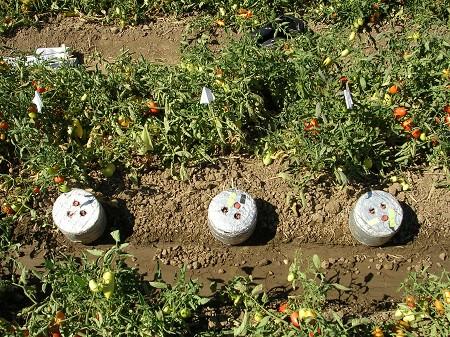Tomato Cultivar Diversity on an Organic Farm

At an organic farm in California, managed biodiversity was manipulated by establishing a mustard cover crop (MCC) and fallow during winter, and after incorporation, tomato mixtures of 1, 3 and 5 cultivars were planted in the spring (1-cv, 3-cv and 5-cv, respectively). It was hypothesized that cultivar mixtures may increase yields over a monoculture if disease pressure or nitrogen (N) availability is affected by the previous cover crop. The monoculture (1-cv) of the grower's preferred cultivar was compared with mixtures of it and other high-yielding cultivars in the region. Soil nitrogen, soil microbial biomass carbon (MBC), soil emissions of carbon dioxide (CO2) and nitrous oxide (N2O), crop nutrient uptake, biomass, fruit quality, intercepted photosynthetically active radiation (PAR), and disease symptoms were measured. The MCC reduced soil N leaching potential during winter, and immobilized soil N early in the tomato season as suggested by higher soil MBC and CO2 emissions. Tomatoes had higher PAR, aboveground biomass, fruit yields, and harvest index in the winter fallow than in the winter MCC, likely due to higher N availability in the fallow plots after transplanting. All cultivar mixtures had fairly similar yield and shoot biomass within fallow and MCC, probably explained by the low genetic diversity among California modern tomato cultivars. However, at mid season (75 days after planting, DAP), the 3-cv mixture had higher shoot and fruit biomass, by 46% and 63%, than the monoculture in the MCC, indicating some plasticity under lower N availability. In the fallow treatment, soil CO2 emissions were lower in the 3-cv mixture than the monoculture at 77 and 100 DAP. Tomatoes in the 3-cv mixture were redder than the monoculture. The 3-cv mixture thus had some minor advantages compared to the monoculture, but overall, there was little evidence of higher ecosystem functions from mixtures vs. monoculture. Further research on mixtures of processing tomatoes may only be warranted for conditions of higher environmental stress than occur in California organic farms, or if specific genotypic traits become available such as for disease resistance or improved nutrient uptake.
Barrios-Masias, F. H., Cantwell, M. I., & Jackson, L. E. Cultivar mixtures of processing tomato in an organic agroecosystem. Org Ag 17–30 (2011). doi:10.1007/s13165-010-0002-z (Barrios-Masias et al. 2011)